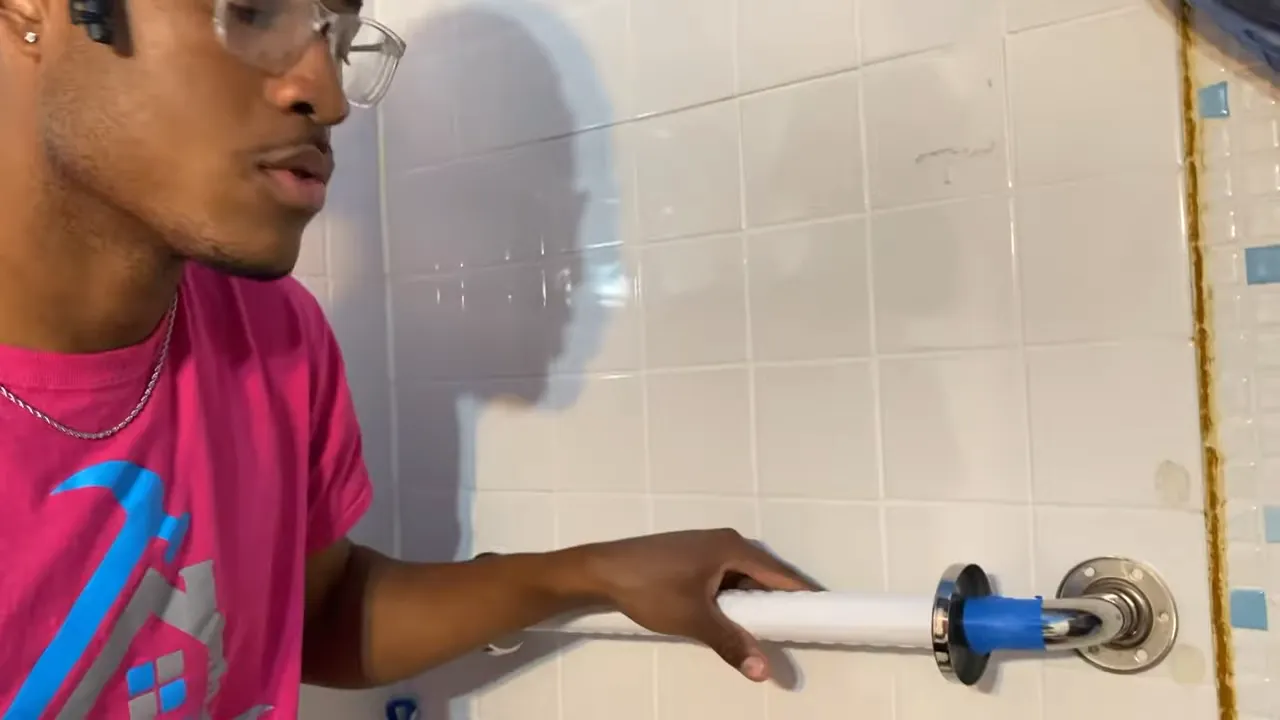To install grab bars without studs, use wall anchors or toggle bolts for added support and stability. Grab bars are an essential safety feature in bathrooms and other areas where stability is crucial, especially for seniors or individuals with mobility issues.
While traditional grab bars are typically mounted into wall studs, this may not always be feasible due to stud placement or other structural limitations. Fortunately, there are alternative methods to install grab bars securely without studs. We will explore different techniques, such as using wall anchors or toggle bolts, to help you successfully install grab bars without compromising safety or stability.
These methods can be applied to various wall surfaces, including drywall, tile, and fiberglass. By following the steps outlined below, you can ensure a solid installation that provides the necessary support for those who need it.
Why Install Grab Bars Without Studs
Grab bars are an essential addition to any bathroom, providing stability and support for individuals of all ages. Traditionally, grab bars are installed into wall studs, which are the vertical wooden beams that make up the framework of a wall. However, there are instances where studs are not conveniently located or may be difficult to locate, making it challenging to install grab bars securely. That’s where installing grab bars without studs becomes necessary.
The Benefits of Grab Bars
Before we delve into the process of installing grab bars without studs, let’s take a moment to understand the numerous benefits that these simple yet effective bathroom accessories offer. Grab bars are not only designed to prevent slips and falls but also provide a sense of independence and reassurance to individuals with limited mobility. Whether you are recovering from surgery, living with a disability, or simply desire added safety in your bathroom, grab bars offer the following advantages:
- Prevent accidents: Grab bars provide stability and prevent accidents by offering a secure grip to hold onto while moving in or out of the shower, standing up or sitting down on the toilet, or maneuvering around the bathroom.
- Promote independence: Installing grab bars allows individuals to navigate their bathroom independently, without relying on assistance from others. This independence enhances self-confidence and improves overall well-being.
- Support all ages: Grab bars are not limited to a specific age group. They benefit individuals of all ages, from young children who need support while learning to use the bathroom to older adults who require additional stability.
- Flexible positioning: Grab bars can be strategically placed in various areas of the bathroom to cater to individual needs. Whether it’s near the toilet, shower, or bathtub, grab bars can be positioned based on the specific requirements of the user.
- Add aesthetic appeal: Nowadays, grab bars are available in a wide range of styles, finishes, and designs. These options allow users to choose grab bars that not only enhance safety but also complement the overall bathroom decor.
Overcoming Stud Limitations
In situations where studs are not readily accessible or do not align with the desired placement of grab bars, alternative installation methods can be employed. There are a few effective techniques for installing grab bars without studs, and these methods include:
- Use Wall Anchors: Wall anchors, also known as hollow wall anchors or drywall anchors, are devices specifically designed to create a secure connection in drywall or plasterboard. These anchors expand behind the wall surface, providing a stable support point for the grab bar.
- Utilize Grab Bar Mounting Kits: Grab bar mounting kits are available in the market, which include specialized hardware designed to secure the grab bar to the wall without the need for studs. These kits often include toggle bolts, anchors, or other innovative solutions.
- Install Blocking: In cases where there is no stud available at the desired location, it may be possible to install additional wooden blocking within the wall. This blocking acts as a solid anchor point for the grab bar installation, ensuring long-lasting support.
By employing these techniques, it is possible to install grab bars securely without relying on studs. However, it is essential to follow the manufacturer’s instructions and consult a professional if unsure about the suitability of the chosen installation method.
Remember, ensuring the safety and stability of grab bars is crucial for their effective function, so taking the necessary steps to install them correctly is of utmost importance.
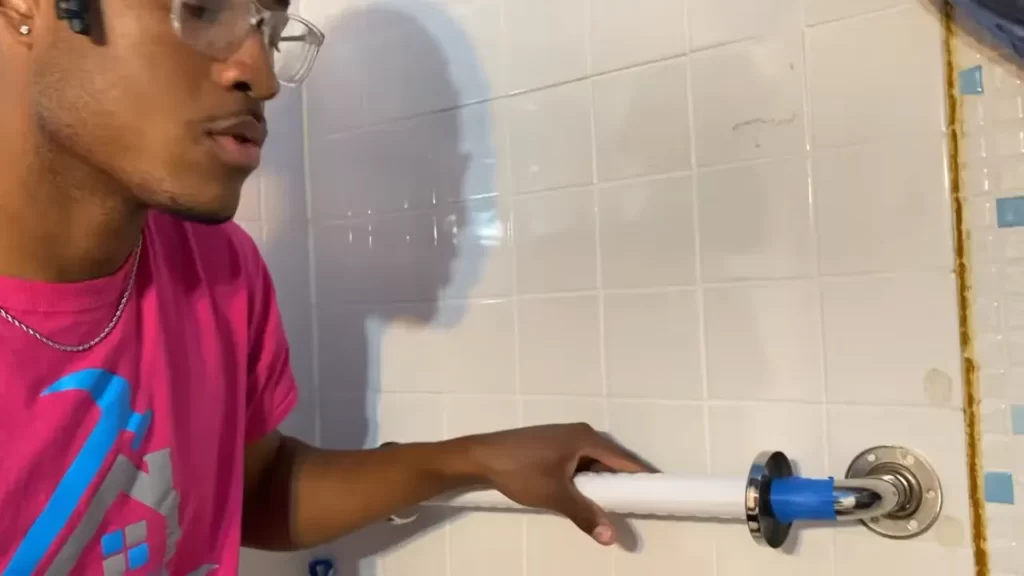
Tools And Materials Needed
Before you begin installing grab bars without studs, it is important to gather all the necessary tools and materials. Having these items ready will ensure a smooth and successful installation process. Here are the essential tools and materials you’ll need:
Choosing the Right Grab Bar
When it comes to selecting the right grab bar for your installation, there are a few factors to consider. The grab bar should be sturdy, durable, and able to support the weight of the person using it. Additionally, it should have a textured surface to provide a secure grip. You can choose from various materials such as stainless steel, chrome, or powder-coated finishes. Choose a style and color that blends well with your bathroom decor.
Essential Tools for Installation
Before you begin the installation process, make sure you have the following tools on hand:
| Tools | Materials |
|---|---|
| Screwdriver | Grab bar |
| Measuring tape | Toggle bolts |
| Level | Wall anchors |
| Pencil | Masking tape |
| Power drill | Marker |
| Tile drill bit |
Having these tools at your disposal will make the installation process much easier and efficient. Make sure your power drill is fully charged, and you have the appropriate drill bits for the type of wall surface you’ll be mounting the grab bar on.
Alternative Mounting Options
If your bathroom walls don’t have studs in the desired location for grab bar installation, don’t worry. There are alternative mounting options available that will still provide a secure and reliable installation. Two popular alternatives are toggle bolts and wall anchors.
Toggle bolts are a great choice for drywall installations. They consist of a spring-loaded toggle that expands behind the wall once inserted, providing a strong anchor point. Wall anchors, on the other hand, are suitable for installations on tile or concrete walls. They are designed to provide a stable base for the grab bar and ensure it stays securely in place.
Now that you know the tools and materials needed, as well as alternative mounting options, you’re ready to start installing grab bars without studs. Remember to follow the manufacturer’s instructions and take all necessary safety precautions. With the right tools and a little bit of patience, you’ll have a sturdy and functional grab bar installed in no time!
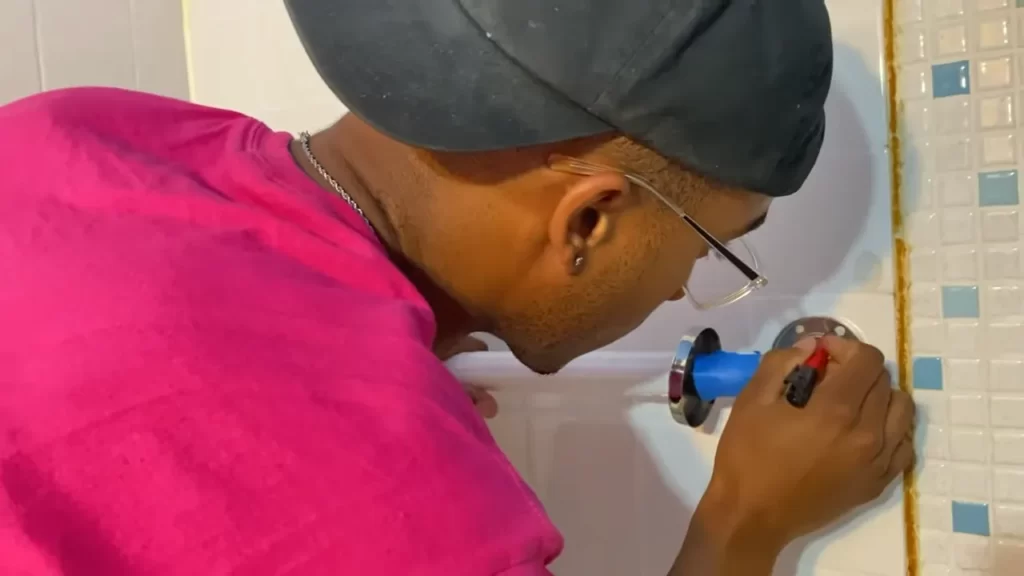
Locating A Suitable Wall Mounting Surface
When it comes to installing grab bars without studs, one of the first and most crucial steps is to locate a suitable wall mounting surface. Without a sturdy and secure surface, your grab bars may not be able to support the weight they are designed for, putting you at risk of accidents or injuries. In this section, we will explore three important factors to consider when locating a suitable wall mounting surface: identifying load-bearing walls, measuring wall thickness, and wall material considerations.
Identifying Load-Bearing Walls
Before installing grab bars without studs, it’s important to identify load-bearing walls in your home. Load-bearing walls are structural elements that carry the weight of the building, making them sturdier and more suitable for supporting grab bars. To identify load-bearing walls:
- Look for walls that run perpendicular to the floor joists or roof rafters, as these walls are more likely to be load-bearing.
- Check for additional support, such as beams or columns, that indicate the wall is load-bearing.
- Consult a professional if you are unsure about the structural integrity of a wall.
Measuring Wall Thickness
Once you’ve identified a potential load-bearing wall, the next step is to measure its thickness. The thickness of the wall will determine the length of the screws or anchors you need to use for installation. To measure wall thickness:
- Use a ruler or tape measure to measure the distance between the outer surface of the wall and the inner surface.
- Make note of the measurement, as you will need it when selecting the appropriate screws or anchors.
Wall Material Considerations
Finally, when installing grab bars without studs, it’s important to consider the material of the wall. Different wall materials may require different installation methods or tools. Here are some common wall materials and considerations:
| Wall Material | Considerations |
|---|---|
| Drywall | Use toggle bolts or wall anchors for secure installation. |
| Tile | Use diamond-tip drill bits and anchors specifically designed for tile. |
| Concrete | Use a hammer drill and concrete anchors for sturdy installation. |
By considering the material of your wall, you can ensure that you have the necessary tools and techniques for a successful installation of grab bars without studs. Remember to always follow the manufacturer’s instructions and consult a professional if needed.
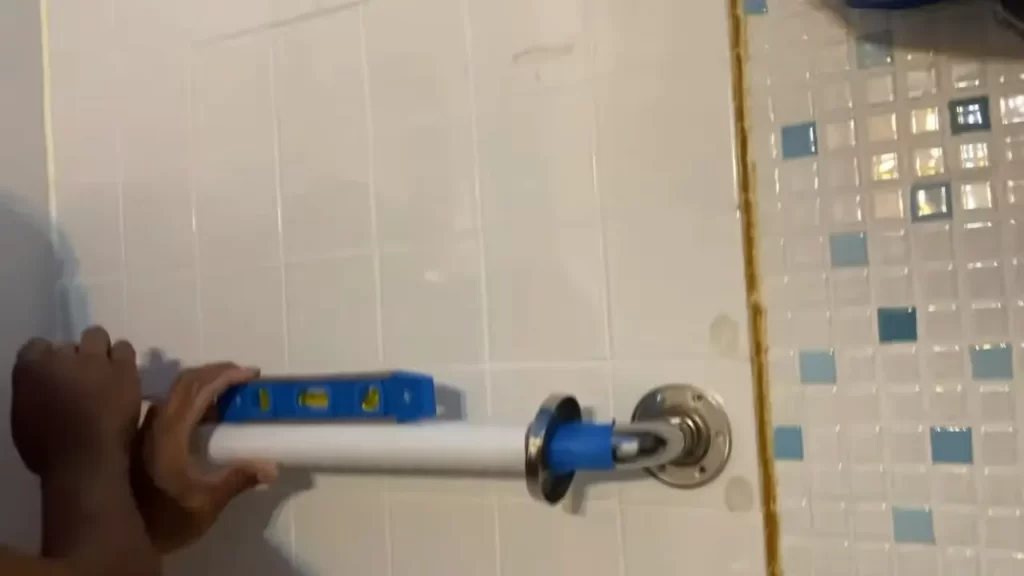
Techniques For Mounting Grab Bars Without Studs
Installing grab bars in your bathroom is an excellent safety precaution, especially for individuals with limited mobility. While traditionally, grab bars are mounted into wall studs for added strength and stability, there are times when studs are not conveniently located. In such cases, it becomes necessary to employ alternative techniques for mounting grab bars without studs. This article will explore three effective methods for installing grab bars without studs: using wall anchors, installing grab bars in tile or drywall, and reinforcing hollow walls for added support.
Using Wall Anchors
Wall anchors are a popular solution when mounting grab bars in walls without studs. They provide a strong anchoring point and distribute the weight of the grab bar across a broader area, ensuring stability and safety. To use wall anchors for mounting grab bars, follow these steps:
- Choose the appropriate wall anchor for your bathroom wall. Plastic or metal anchors are commonly used for this purpose.
- Place the anchor in the desired location on the wall and mark the spots for drilling holes.
- Drill holes into the marked spots using a drill bit that matches the size of the wall anchor.
- Insert the wall anchor into the holes and tap gently to ensure a secure fit.
- Attach the grab bar to the wall by aligning the mounting holes with the wall anchors and securing them with screws.
- Tighten the screws firmly, ensuring the grab bar is securely mounted on the wall.
Installing Grab Bars in Tile or Drywall
Many bathrooms feature tile or drywall, which can present challenges when installing grab bars. However, with the right techniques, it is possible to mount grab bars in these surfaces securely. Follow these steps to install grab bars in tile or drywall:
- Choose a suitable location where the grab bar will provide optimal support.
- Mark the spot for drilling by using a level to ensure the grab bar will be straight.
- Drill holes into the tile or drywall using a masonry or tile drill bit.
- Insert plastic wall anchors into the drilled holes.
- Align the mounting holes of the grab bar with the wall anchors and attach it to the wall using screws.
- Make sure the screws are tightened securely.
Reinforcing Hollow Walls for Added Support
For walls with no studs or insufficient structural support, reinforcing the hollow walls is crucial to ensure the grab bar can withstand the required weight. Here’s how you can reinforce hollow walls:
- Identify the hollow wall area where the grab bar will be mounted.
- Cut a hole in the drywall to access the hollow space.
- Insert a block of wood or a metal bracket into the hollow space behind the drywall.
- Secure the block of wood or metal bracket to the drywall using screws.
- Once the reinforcement is in place, mount the grab bar using the appropriate hardware and screws.
- Ensure the screws are tightened firmly to provide maximum support.
By following these techniques for mounting grab bars without studs, you can enhance the safety and accessibility of your bathroom. Remember to always consult a professional if you are unsure about any aspect of the installation process. Safety should be the top priority when installing grab bars in your home.
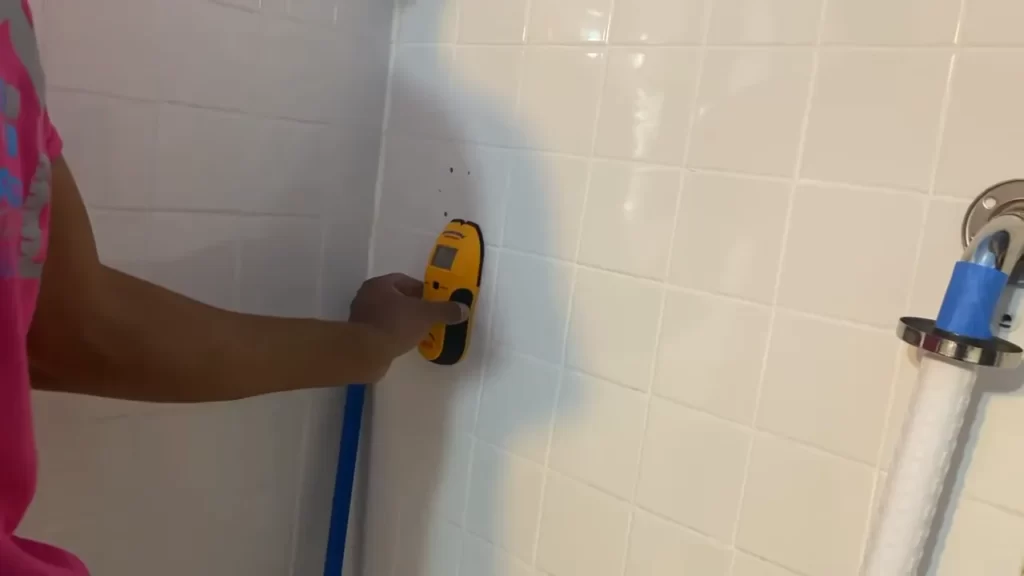
Installation Process
Installing grab bars without studs is an essential safety precaution for anyone looking to add extra support and stability in their bathrooms or other areas of the home. While traditional grab bars rely on studs for a secure installation, there are alternative methods available that can provide a strong and reliable hold even without studs. In this guide, we will take you through the step-by-step installation process to help you add grab bars without studs and enhance the safety of your living spaces.
Preparing the Mounting Area
Before beginning the installation process, it is crucial to prepare the mounting area properly. Ensure that the wall surface is clean and free from any debris that might hinder the installation process. Additionally, make sure to select the right location for the grab bar, considering the user’s needs and the accessibility of the area. Take into account factors such as the user’s height, reach, and any specific requirements.
Marking the Drill Points
After preparing the mounting area, the next step is to mark the drill points accurately. Using a tape measure, locate and mark the exact spots where you want to install the grab bar. It is recommended to use a level to ensure that the marks are straight and aligned properly. By doing so, you can avoid any installation mishaps and ensure a secure and level installation.
Drilling Holes for Anchors
Once the drill points are marked, it’s time to start drilling the holes for the anchors. Carefully select the appropriate drill bit size for the anchors you plan to use. Avoid using excessive force when drilling, as it can damage the wall. Use a steady and controlled technique to create clean, precise holes at the marked drill points.
Inserting Anchors and Mounting the Grab Bar
After drilling the holes, insert the anchors into each hole. Make sure they fit snugly to provide a secure hold. Then, align the grab bar with the drilled holes, ensuring it is level and straight. Securely attach the grab bar to the wall by screwing it into the anchors using the provided screws. Ensure that the screws are tightened firmly enough to hold the grab bar securely in place, but be cautious not to overtighten and damage the anchoring system.
Testing the Grab Bar’s Stability
Once the grab bar is mounted, it’s vital to test its stability before relying on it for support. Give the grab bar a firm tug in different directions to assess its strength and stability. Ensure that it remains securely attached to the wall with no wiggling or movement. A properly installed grab bar should provide a stable and secure support system.
By following this step-by-step installation guide, you can install grab bars without studs and enhance the safety of your living spaces. Remember, grab bars offer invaluable support, especially for individuals with limited mobility or balance issues. Prioritize safety by installing grab bars using the appropriate methods even in areas without wall studs.
Maintenance And Safety Considerations
Regular maintenance and proper care are essential to ensure the safety and longevity of grab bars. By regularly inspecting and tightening grab bars, cleaning them appropriately, and ensuring optimal weight capacity, you can create a safer bathroom environment for everyone. In this section, we will discuss the important maintenance and safety considerations to keep in mind while installing grab bars without studs.
Regularly Inspecting and Tightening Grab Bars
Regularly inspecting and tightening grab bars is crucial to guarantee their stability and effectiveness. Over time, grab bars may become loose due to frequent use or temperature changes. Therefore, it is important to check the tightness of the screws or mounting hardware at least once a month. If any loosening is detected, promptly tighten the screws to ensure that the grab bars remain securely attached to the wall.
Cleaning and Care Tips for Grab Bars
Proper cleaning and care of grab bars not only ensure their longevity but also prevent the accumulation of dirt and germs. To clean grab bars, use a non-abrasive cleaner and a soft cloth or sponge. Avoid using harsh chemicals or abrasive materials that may scratch the surface of the grab bars. Additionally, regularly sanitize the grab bars using a disinfectant to maintain a hygienic bathroom environment.
Ensuring Optimal Weight Capacity
When installing grab bars without studs, it is important to ensure their optimal weight capacity. Before purchasing grab bars, carefully read and follow the manufacturer’s weight limitations to ensure that they can support the intended load. Avoid using grab bars beyond their specified weight limits, as this can compromise both their safety and durability. If necessary, consult with a professional to determine the appropriate grab bars that can accommodate the desired weight.
Frequently Asked Questions
How Do You Attach A Grab Bar Without Studs?
To attach a grab bar without studs, use an adhesive grab bar mounting system specifically designed for this purpose. Follow the manufacturer’s instructions to ensure proper installation and ensure the adhesive is suitable for the surface.
Do Grab Bars Need To Be In Studs?
Yes, grab bars need to be installed in studs for maximum strength and stability. Studs provide the necessary support to hold the weight and ensure the grab bars stay securely in place. Installing grab bars in studs helps prevent accidents and injuries.
Can Grab Bars Be Installed In Drywall?
Yes, grab bars can be installed in drywall. However, it is important to ensure that they are mounted securely to studs or using heavy-duty wall anchors for proper support and stability. It is recommended to consult a professional for installation to ensure safety.
How Do You Anchor Grab Bars?
To anchor grab bars, follow these steps: 1. Determine the ideal location for the bar. 2. Use a stud finder to locate the wall studs. 3. Mark the spots where the screws will go. 4. Drill pilot holes at the marked spots.
5. Attach the grab bar to the wall using screws, ensuring a secure fit.
Conclusion
Installing grab bars without studs is an achievable process that can greatly enhance bathroom safety. By following the steps outlined in this blog post, you can ensure a secure and reliable installation. Remember to choose the appropriate installation method and use the right tools for the job.
With some patience and careful planning, you can successfully install grab bars without studs and create a safer environment for yourself or your loved ones.
